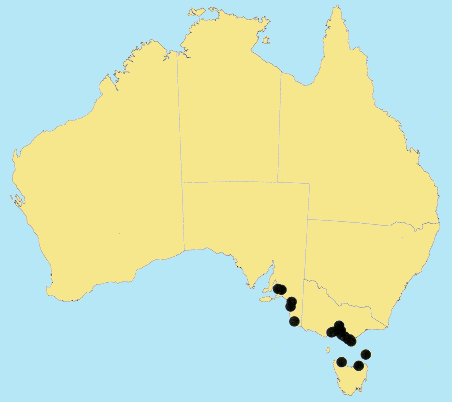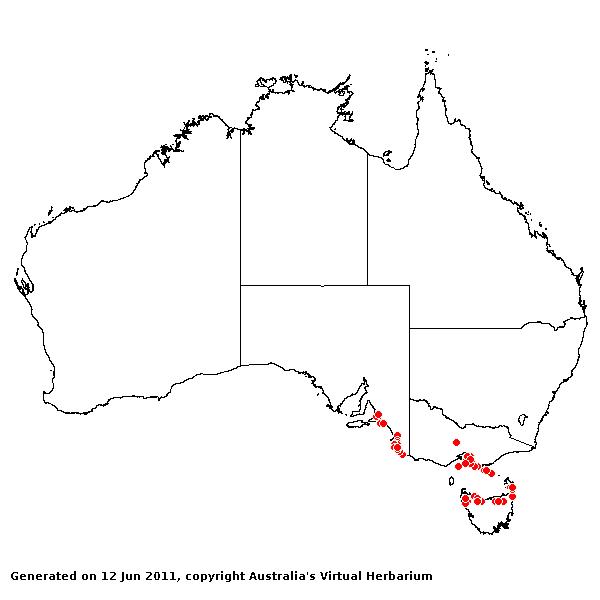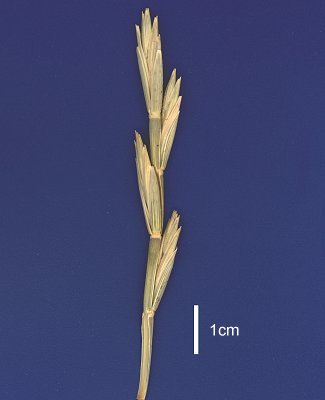Thinopyrum junceiforme* (A. Love & D. Love) Á.Löve. Taxon 29: 351
(1980).
Classification. (GPWG 2001) : Subfamily Pooideae.
Tribe Triticeae.
Basionym and/or
Replacement Name: Elytrigia
junceiformis Á. Löve & D. Löve, Rit Landbunaoard. Atvinnud.
Haskolans, B 3: 106 (1948); Agropyron junceum subsp. boreali-atlanticum
Simonet ex Guin., Bull. Soc. Bot. France 85: 176 (1938).
Recent synonyms:
Agropyron junceiforme Á.Löve & D.Löve, A. junceum auct. non.
(L.) P.Beauv.
Key references
(books and floras): [2002] D.Sharp & B.K.Simon, AusGrass, Grasses of
Australia, [2006] J.Jessop, G.R.M.Dashorst, F.M.James, Grasses of South
Australia (277), [2009] A.Wilson (ed.). Flora of Australia, Vol 44A.
Poaceae 2 (103).
Illustrations:
[2006] J.Jessop, G.R.M.Dashorst, F.M.James, Grasses of South Australia (278, fig. 216).
Habit.
Perennial. Rhizomes absent or present, elongated. Culms erect, 20–75 cm tall.
Leaves cauline. Leaf-sheaths glabrous on surface. Leaf-sheath auricles absent.
Ligule an eciliate membrane, 0.5–1.25 mm long, hyaline or membranous, truncate.
Leaf-blades flat or involute, 10–38.5 cm long, 1.5–6 mm wide. Leaf-blade
surface indumented.
Inflorescence.
Inflorescence solid, a raceme. Racemes 1, erect, 4–20 cm long, bearing 9–11
fertile spikelets on each. Rhachis fragile at the nodes.
Spikelets.
Spikelets sessile. Fertile spikelets many flowered, with at least 2 fertile
florets (3–8), comprising 3–8 fertile floret(s), with diminished florets at the
apex, oblong or cuneate, laterally compressed, 15–28 mm long.
Glumes. Glumes
similar. Lower glume elliptic or oblong or ovate, cartilaginous or coriaceous,
without keels or keeled, 1-keeled, 7–12 -nerved. Upper glume oblong, 9–20 mm
long, coriaceous, keeled, 1-keeled, 7–13 -nerved. Upper glume surface smooth.
Florets.
Fertile lemma 11–20 mm long, keeled, 5 -nerved. Lemma apex mucronate. Palea 2
-nerved. Lodicules present. Anthers 3.
Continental
Distribution: Europe, Africa, Temperate Asia, Australasia, and North
America.
Australian
Distribution: South Australia, Victoria, Tasmania.
South Australia:
Southern Lofty, South-eastern. Victoria: Gippsland Plain, Otway Plain,
Wilsons Promontory. Tasmania: Furneaux Group, North West.
Notes.
Introduced for sand dune stabilisation.
The morphologically variable species Thinopyrum
junceum and T. junceiforme are widely recorded as being introduced
into Australia, there being a number of collections under both names in
Australian herbaria. However, according to Melderis' (1980) treatment, these
taxa are unequivocally distinguishable only by differences in anther length and
somatic chromosome number (anthers 10–12 mm long and 2n=42 or 56 in Elymus
farctus subsp. farctus (=T. junceum) vs. anthers 6–8 mm long
and 2n= 28 in E. farctus subsp. boreali-atlanticus (=T.
junceiforme). All Australian material examined to date possess anthers of
6–8 mm, thus, it is likely that if T. junceum is present in Australia it
is of very restricted distribution and not present in any national herbaria.


Native to the
Mediterranean, introduced into North America. Commonly located just above the
high tide zone. Flowers Nov.-Dec.


